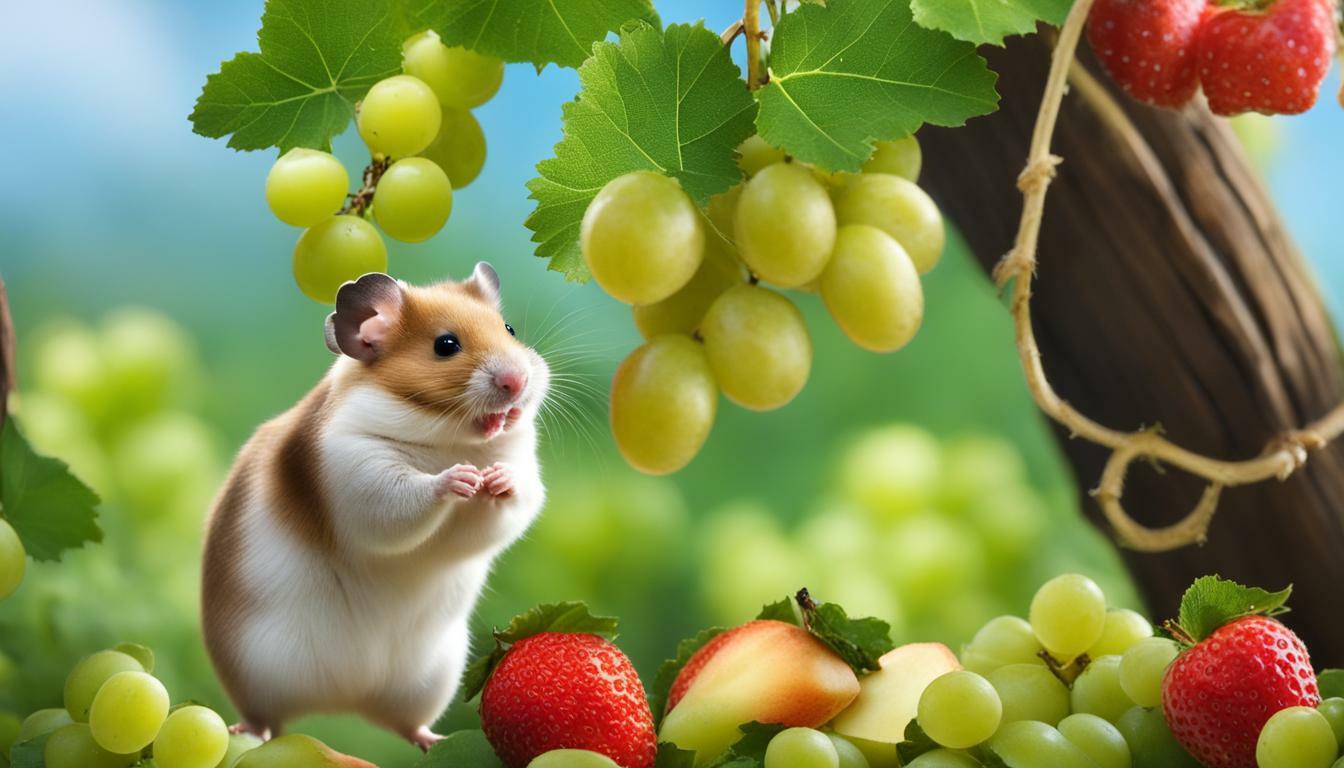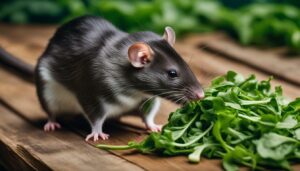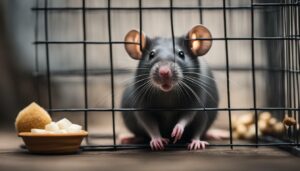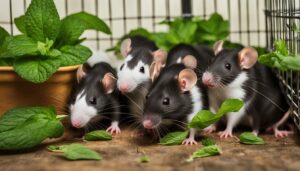If you’re wondering whether it’s safe to feed your hamster green grapes, you’ve come to the right place. Hamsters have specific dietary needs, and it’s important to ensure they have a balanced and healthy diet. While green grapes can be a tasty treat for your furry friend, it’s essential to feed them in moderation and take certain precautions to keep your hamster safe and healthy.
- Hamsters can safely eat green grapes in small quantities.
- Grapes are full of antioxidants and important vitamins and minerals.
- Too much grape can cause upset stomach, diarrhea, and unhealthy weight gain in hamsters.
- Remove seeds and peel grapes before feeding them to hamsters.
- Feed hamsters a small portion of grape (about a teaspoon) twice a week.
The Benefits of Fruits in a Hamster’s Diet
Adding fruits to your hamster’s diet can provide a range of health benefits and serve as a tasty and nutritious addition to their daily meals. Fruits are rich sources of antioxidants, vitamins, and minerals that can support your hamster’s overall wellbeing. They can help boost their immune system, improve digestion, and provide essential nutrients for optimal health.
One of the best fruits for hamsters is banana. It is easily digestible and packed with potassium, vitamin C, and vitamin B6. Another great option is pear, which is high in fiber and can aid in regulating your hamster’s digestive system. Apples are also a good choice, as they offer vitamin C and dietary fiber.
Blueberries and strawberries are excellent sources of antioxidants, which can help combat free radicals and promote a healthy heart. Watermelon, with its high water content, is a refreshing treat for your hamster and can help keep them hydrated. Remember to remove any seeds and peel the fruits before feeding them to your furry friend to prevent choking hazards.
By incorporating a variety of hamster-friendly fruits into their diet, you can ensure that your pet receives a well-rounded nutritional intake. However, it’s important to remember that fruits should only be given in small quantities as treats and not as a primary food source. A teaspoon of fruit twice a week should suffice to avoid any potential digestive issues or weight gain for your hamster.
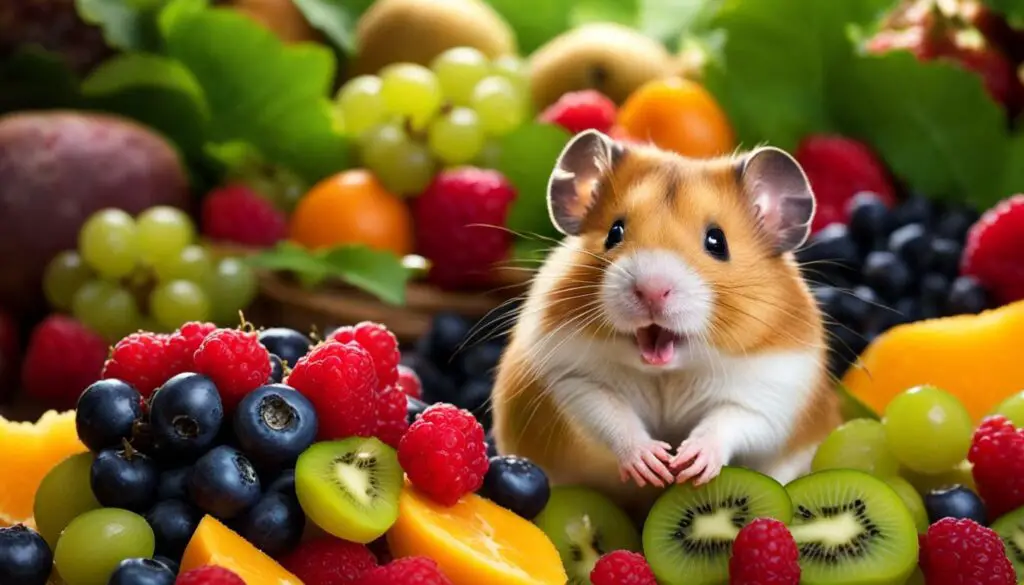
Exploring the Nutritional Value of Green Grapes
Green grapes are a rich source of antioxidants, vitamins, and minerals that can support your hamster’s overall health. These small fruits are packed with nutrients that can provide various benefits to your furry friend. One of the key components found in green grapes is antioxidants, which help protect hamsters from cell damage caused by harmful free radicals.
Additionally, green grapes contain important vitamins such as vitamin C and vitamin K. Vitamin C is essential for a hamster’s immune system, as it helps fight off infections and boosts overall health. Vitamin K is crucial for proper blood clotting, ensuring that your hamster’s body can heal from any injuries or wounds.
When it comes to minerals, green grapes offer potassium and manganese. Potassium helps regulate your hamster’s blood pressure and promotes healthy heart function. Manganese, on the other hand, plays a vital role in bone health and supports optimal brain function.
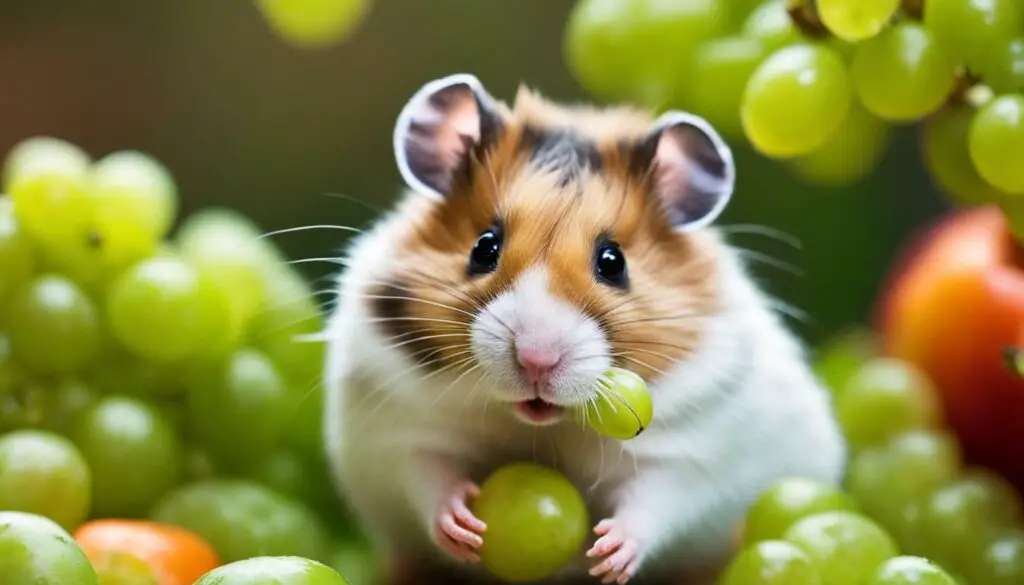
While green grapes offer these nutritional benefits, it’s important to feed them to your hamster in moderation. Too much grape can lead to digestive issues such as upset stomach and diarrhea. Additionally, grapes are high in natural sugars, which can contribute to unhealthy weight gain in your hamster if consumed excessively. It is recommended to give your hamster small portions of grapes, about a teaspoon, no more than twice a week.
Remember to remove the seeds and peel the grapes before feeding them to your hamster, as these parts can be a choking hazard. Always prioritize your hamster’s safety and well-being when introducing new foods into their diet.
Additional Nutritious Fruits for Your Hamster
Aside from green grapes, there are other delicious and nutritious fruits that your hamster can enjoy. Consider adding a variety of fruits to your hamster’s diet to provide them with a range of nutrients. Some safe options include:
- Bananas: A great source of potassium and vitamin B6
- Pears: Provide fiber and vitamin C
- Apples: Rich in antioxidants and fiber
- Blueberries: Packed with antioxidants and vitamin C
- Strawberries: Contain vitamin C and fiber
- Watermelon: Hydrating and offers essential vitamins and minerals
These fruits can be offered to your hamster in small, appropriately sized portions as occasional treats. Remember to introduce new foods gradually and monitor your hamster’s response to ensure they tolerate them well.
In conclusion, green grapes can be included in your hamster’s diet as an occasional treat. While they offer nutritional benefits, they should not be a regular part of your hamster’s daily meals. Remember to feed grapes in moderation, remove seeds and peel, and prioritize the safety and well-being of your furry friend.
Moderation is Key: Guidelines for Feeding Green Grapes to Hamsters
While green grapes can be a healthy snack for your hamster, it’s crucial to feed them in moderation to prevent digestive issues and weight gain. Grapes are packed with antioxidants, vitamins, and minerals that can benefit your furry friend, but consuming too much can lead to stomach upset, diarrhea, and unhealthy weight gain. To ensure your hamster enjoys the benefits of grapes without any negative effects, here are some guidelines to follow:
- Portion Size: Give your hamster a small portion of green grapes, about a teaspoon, twice a week. This will provide them with a tasty treat without overloading their digestive system.
- Seed Removal: Before offering grapes to your hamster, make sure to remove all the seeds. Grape seeds can be a choking hazard and may cause intestinal blockages if ingested.
- Peeling: It’s recommended to peel the grapes before feeding them to your hamster. The skin can be tough to digest and may cause digestive discomfort.
Remember, grapes should not be a regular part of your hamster’s diet. They should be given as an occasional treat in addition to their regular hamster food. Offering a variety of healthy snacks, such as fruits and vegetables, will ensure a well-balanced diet for your pet.
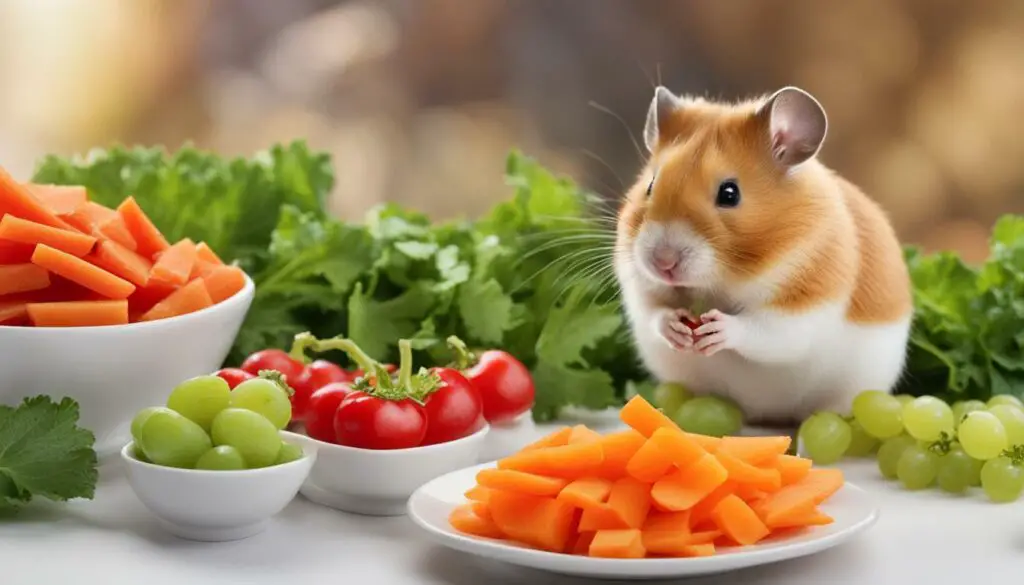
Quote: “Feeding your hamster grapes in moderation can provide them with a tasty and nutritious treat. Just make sure to follow the guidelines to keep them healthy and happy.” – Dr. Rachel Johnson, DVM
Hamster-Friendly Fruits: A Quick Guide
In addition to green grapes, there are several other fruits that hamsters can enjoy as part of their diet. Here’s a list of hamster-friendly fruits:
| Fruit | Benefits |
|---|---|
| Banana | Provides potassium and dietary fiber |
| Pear | Rich in vitamins C and K |
| Apple | Offers vitamins A and C |
| Blueberry | Contains antioxidants and vitamin C |
| Strawberry | High in vitamin C and dietary fiber |
| Watermelon | Hydrating and a source of vitamins A and C |
These fruits can be served fresh and washed thoroughly to ensure they’re safe for your hamster. Remember to introduce new foods gradually and monitor your hamster’s reaction to ensure they tolerate them well.
Preparing Green Grapes for Your Hamster
Before offering green grapes to your hamster, make sure to remove the seeds and peel the grapes to ensure they are safe and easily digestible. Hamsters have delicate digestive systems, and the seeds of grapes can be a choking hazard and cause intestinal blockages. Peeling the grapes will help prevent any pesticides or chemicals from the skin from being ingested by your furry friend. By taking these precautions, you can provide a safe and healthy snack for your hamster.
To prepare the green grapes, start by washing them thoroughly to remove any dirt or residue. Then, gently remove the stem and carefully peel the skin off each grape. It’s essential to be gentle while peeling to avoid squishing the grape and making it difficult for your hamster to eat. Once the grapes are peeled, cut them into small, bite-sized pieces that your hamster can easily hold and consume. Remember to wash your hands before handling the grapes to avoid transferring any harmful bacteria or contaminants to your pet.
Feeding your hamster a variety of fruits is important to ensure they receive a balanced diet. While green grapes can be a tasty and nutritious treat, it’s crucial to offer them in moderation. Too many grapes can lead to an upset stomach, diarrhea, and even unhealthy weight gain in hamsters. Stick to small portions, offering about a teaspoon of grapes twice a week. This will provide your hamster with a flavorful snack while keeping their diet balanced and healthy.
| Fruit | Feeding Frequency | Portion Size |
|---|---|---|
| Green Grapes | Twice a week | About a teaspoon |
| Banana | Once a week | Half an inch slice |
| Pear | Once a week | Small cube |
| Apple | Once a week | Thin slice |
| Blueberry | Twice a week | 2-3 berries |
| Strawberry | Once a week | Half a berry |
| Watermelon | Once a week | Small cube |
Remember, every hamster is unique, and their dietary needs may vary. It’s always best to consult with a veterinarian who specializes in small animals to ensure you are providing the right nutrition for your individual hamster. By following these guidelines and offering a variety of safe fruits in moderation, you can treat your hamster to a healthy and enjoyable diet.
Expert Tip:
“Hamsters are omnivores and enjoy a diverse diet. However, fruits should always be offered as treats and not comprise the majority of their diet. A mix of fresh vegetables, high-quality hamster pellets, and occasional fruits will help keep your hamster healthy and happy.”
– Dr. Emily Harper, Veterinarian
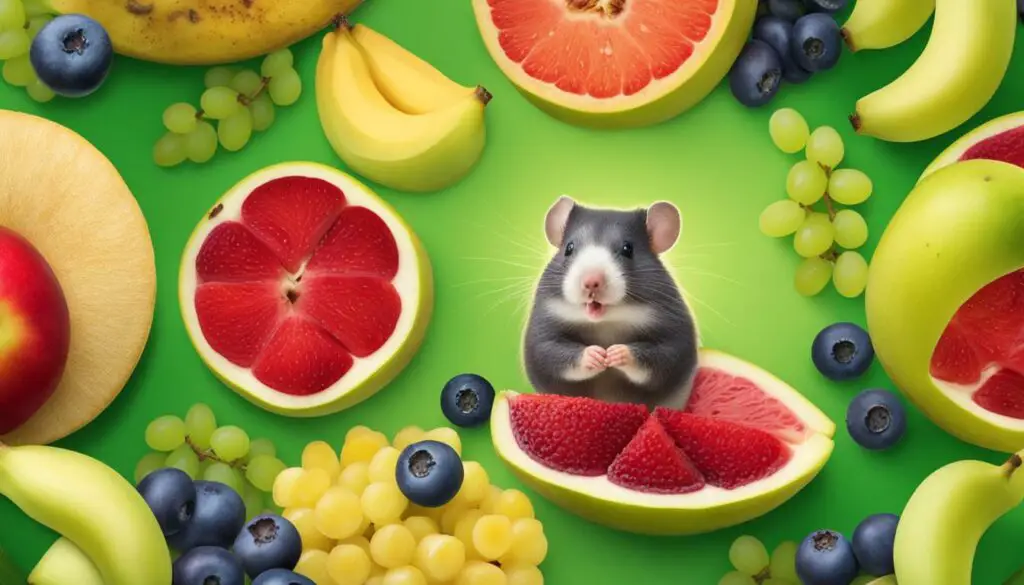
In summary, green grapes can be a safe and healthy addition to your hamster’s diet when prepared correctly and offered in moderation. Remember to remove the seeds and peel the grapes before feeding them to your pet. Offering a variety of fruits, such as banana, pear, apple, blueberry, strawberry, and watermelon, can provide your hamster with a well-rounded diet. However, it’s important to consider the specific needs of your hamster breed, as Chinese Dwarf Hamsters are more prone to diabetes and should avoid grapes altogether. By following these guidelines and consulting with a veterinarian, you can ensure that your hamster receives a balanced and nutritious diet that promotes their overall well-being.
Other Fruits That Hamsters Can Enjoy
Green grapes are not the only fruit your hamster can enjoy – there are plenty of other options that can provide a tasty and nutritious addition to their diet. While grapes offer some health benefits, it’s important to offer variety to ensure a balanced diet for your furry friend.
Here is a list of other fruits that are safe and healthy for hamsters:
- Bananas: Rich in potassium and fiber, bananas make a great occasional treat for hamsters. Just make sure to remove the peel and offer small, bite-sized pieces.
- Pears: Pears are a good source of vitamins and minerals, and hamsters love their sweet taste. Cut them into small pieces without the seeds or the skin.
- Apples: Apples can be a refreshing and crunchy snack for hamsters. Remove the seeds, core, and peel before serving.
- Blueberries: These tiny berries are packed with antioxidants and make a great treat for hamsters. Offer them in moderation as they can be high in natural sugars.
- Strawberries: Sweet and juicy, strawberries are a favorite among hamsters. Remember to remove the green leafy top and cut them into small pieces.
- Watermelon: A hydrating and refreshing fruit, watermelon is safe for hamsters to enjoy. Remove the seeds and the rind before serving.
Remember, even with these fruits, moderation is key. Treats should make up no more than 10% of a hamster’s daily diet. Offer a small, bite-sized portion once or twice a week to keep your hamster healthy and happy.
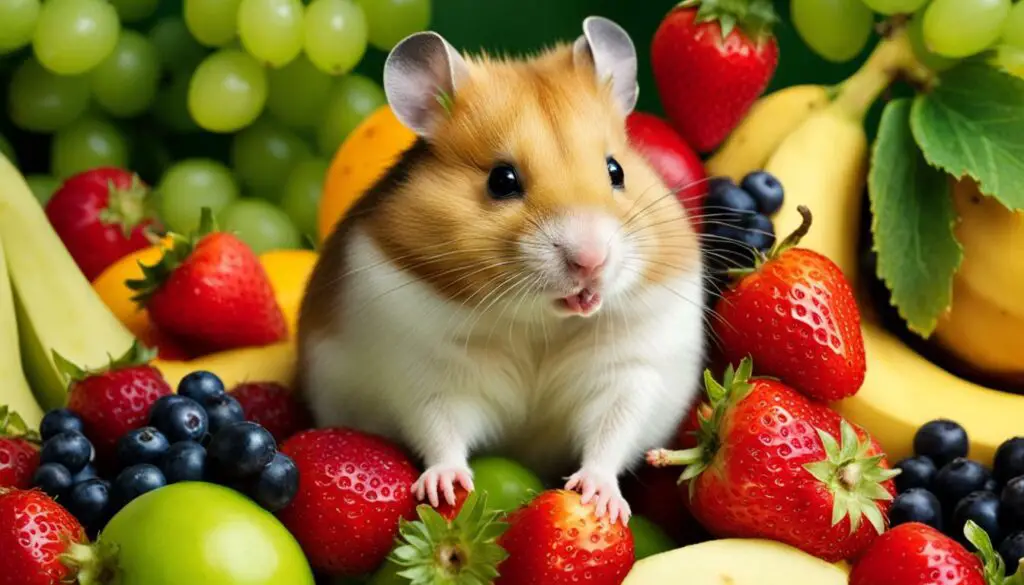
Providing a variety of fruits alongside a balanced diet of pellets, fresh vegetables, and water will ensure that your hamster receives the necessary nutrients for optimal health. Keep in mind that some fruits may be better tolerated by certain hamster breeds, so always monitor your pet’s reaction and adjust their diet accordingly.
Considerations for Chinese Dwarf Hamsters
If you have a Chinese Dwarf Hamster, it’s important to be cautious when it comes to their fruit intake due to their higher risk of developing diabetes. While fruits can be a healthy and enjoyable addition to a hamster’s diet, Chinese Dwarf Hamsters are more prone to diabetes, which means their sugar intake should be carefully monitored. This includes being mindful of the fruits they consume.
Chinese Dwarf Hamsters should be fed a diet that is low in sugar and carbohydrates to help prevent the onset of diabetes. When it comes to fruits, it’s best to avoid feeding Chinese Dwarf Hamsters grapes, as they are naturally high in sugar content. Instead, focus on offering them other safe fruit options that are lower in sugar.
Some suitable fruits for Chinese Dwarf Hamsters include small portions of blueberries, strawberries, or watermelon. These fruits are lower in sugar compared to grapes and can still provide essential nutrients without increasing the risk of diabetes. Remember to feed them these fruits in moderation and as part of a balanced diet.
Always consult with a veterinarian or a knowledgeable pet professional for specific guidance on your Chinese Dwarf Hamster’s dietary needs. They can provide tailored advice based on your hamster’s individual health and dietary requirements, ensuring they maintain a happy, healthy, and diabetes-free life.
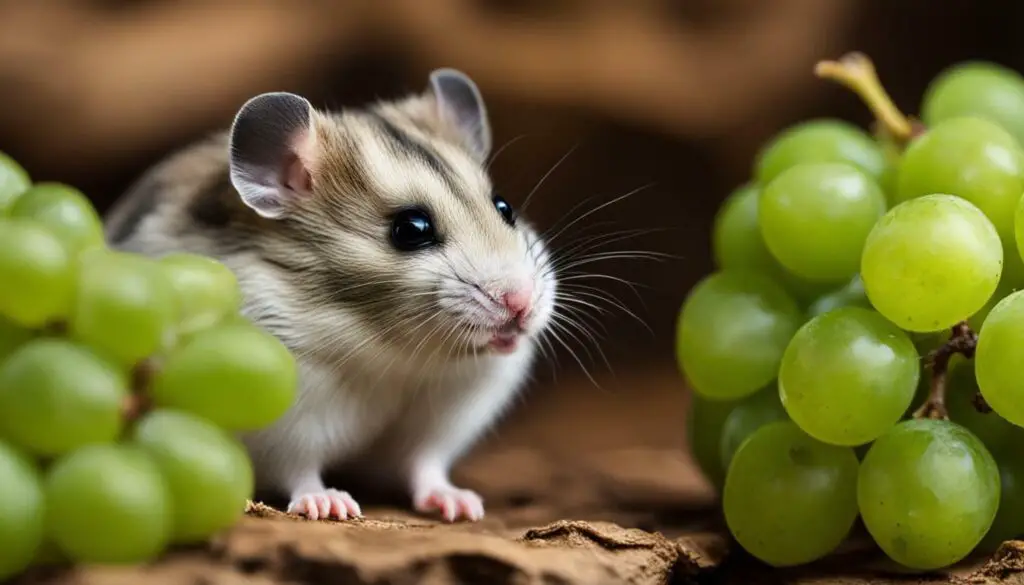
| Fruit | Sugar Content (per 100g) |
|---|---|
| Green Grapes | 16g |
| Blueberries | 10g |
| Strawberries | 4.9g |
| Watermelon | 6g |
Hamsters and Grape Consumption: A Summary
To recap, while green grapes can be enjoyed by most hamsters, it’s essential to feed them in moderation and consider individual breed differences. Grapes offer some health benefits, but too much can lead to digestive issues and weight gain. To ensure the safety of your furry friend, follow these guidelines:
- Remove the seeds and peel the grapes before feeding them to your hamster. This helps prevent choking hazards and ensures they can digest the fruit easily.
- Offer grapes as a treat rather than a staple in their diet. A small portion of about a teaspoon, twice a week, is sufficient.
- Pay attention to your hamster’s reaction. If they show signs of discomfort or digestive upset after eating grapes, it’s best to avoid feeding them in the future.
While grapes can be a tasty and nutritious addition to your hamster’s diet, remember that variety is key. Include other fruits such as banana, pear, apple, blueberry, strawberry, and watermelon to provide a well-rounded diet. Each fruit offers different vitamins and minerals, ensuring your hamster gets a range of nutrients.
Chinese Dwarf Hamsters and Grape Consumption
It’s important to note that Chinese Dwarf Hamsters are more prone to diabetes compared to other breeds. Therefore, it is best to avoid feeding them grapes altogether, as the high sugar content can exacerbate their risk. Syrian and Roborovski hamsters are less likely to develop diabetes and can safely enjoy small amounts of grapes.
Overall, while green grapes can be a tasty treat for most hamsters, it’s crucial to consider their individual dietary needs and feed them in moderation. By providing a balanced and varied diet, you can ensure your hamster stays healthy and happy.
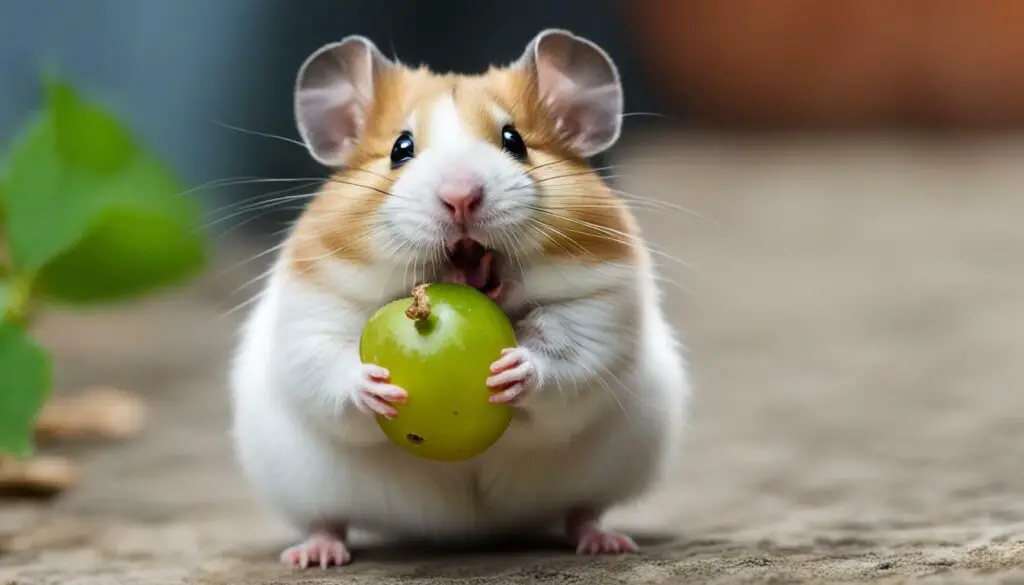
Green grapes can be a healthy addition to your hamster’s diet as long as they are given in moderation and as part of a well-balanced meal plan. These small fruits pack a punch when it comes to antioxidants, vitamins, and minerals that can help support your furry friend’s overall wellbeing.
However, it’s important to remember that hamsters have sensitive digestive systems, and consuming too much grape can lead to upset stomach, diarrhea, and even unhealthy weight gain. To ensure your hamster enjoys the benefits of grapes without any negative side effects, it’s crucial to feed them in moderation.
When feeding your hamster grapes, always remove the seeds and peel the skin to make it easier for them to digest. Additionally, it’s best to offer only a small portion, about a teaspoon, twice a week. This allows your hamster to indulge in the natural sweetness while still maintaining a balanced diet.
In addition to green grapes, there are several other fruits that can make healthy snacks for your hamster. Bananas, pears, apples, blueberries, strawberries, and watermelon can all be enjoyed by your furry friend. Just like with grapes, remember to serve these fruits in small portions and as occasional treats.
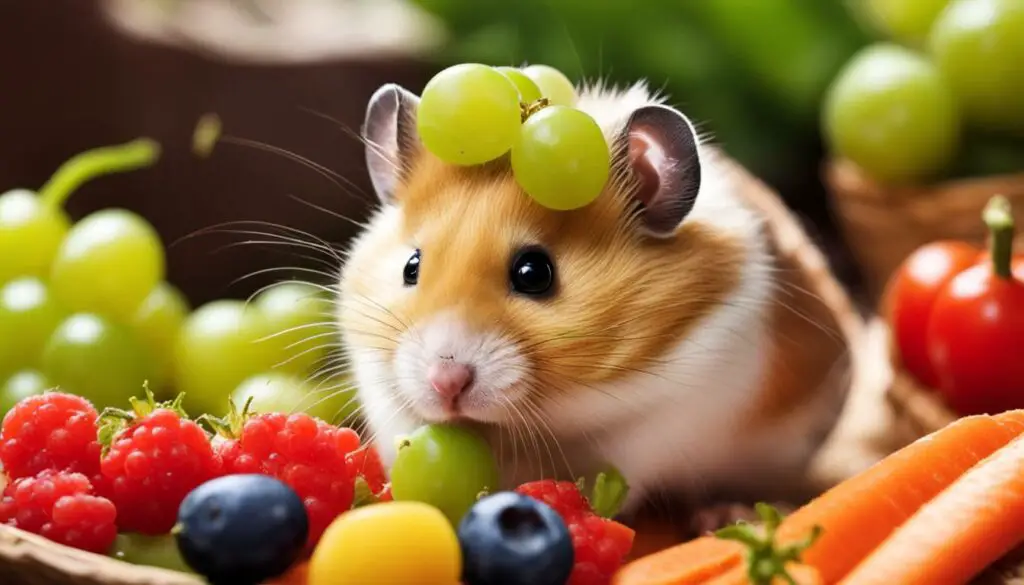
It’s worth noting that Chinese Dwarf Hamsters are at a higher risk of developing diabetes. Therefore, it’s best to avoid feeding them grapes altogether. Syrian and Roborovski hamsters, on the other hand, are less prone to diabetes and can enjoy grapes in moderation.
While grapes offer some health benefits for hamsters, it’s important to remember that they should not constitute a regular part of their diet. Variety is key when it comes to keeping your hamster happy and healthy, so be sure to incorporate a range of fruits and other nutritious foods into their meal plan.
| Safe Fruits for Hamsters | Feeding Frequency |
|---|---|
| Bananas | Twice a week |
| Pears | Twice a week |
| Apples | Twice a week |
| Blueberries | Twice a week |
| Strawberries | Twice a week |
| Watermelon | Twice a week |
Remember to always consult with a veterinarian before making any changes to your pet’s diet. With proper care and attention, your hamster can enjoy a varied and nutritious diet that includes the occasional treat of green grapes.
Conclusion
In conclusion, green grapes can be a safe and healthy treat for your hamster if offered in moderation, alongside a varied and nutritionally balanced diet. Grapes are packed with antioxidants, vitamins, and minerals that can benefit your furry friend. However, it’s important to remember that overfeeding grapes can lead to stomach issues, diarrhea, and weight gain in hamsters. Therefore, it’s crucial to exercise caution and feed grapes in small quantities.
To ensure the safety of your hamster, always remove the seeds and peel the grapes before feeding them. A small portion of grapes, around a teaspoon, twice a week is sufficient for most hamsters. It’s essential to monitor your hamster’s reaction to grapes and adjust the portion size accordingly to prevent any digestive issues.
While grapes can be a delightful treat, it’s equally important to offer a variety of fruits in your hamster’s diet. Other hamster-friendly fruits include bananas, pears, apples, blueberries, strawberries, and watermelons. These fruits provide additional nutrients and flavors for your hamster to enjoy.
However, it’s crucial to note that Chinese Dwarf Hamsters are more susceptible to diabetes. Therefore, it is best to avoid feeding them grapes to reduce the risk of potential health complications. Syrian and Roborovski hamsters, on the other hand, are less prone to diabetes and can safely consume grapes, following the moderation guidelines.
In summary, while green grapes can be a healthy and tasty addition to your hamster’s diet, they should be offered in moderation. Remember to prioritize variety in your hamster’s food choices and maintain a balanced diet for their overall well-being. By following these guidelines, you can ensure that your hamster enjoys the occasional treat without compromising their health.
FAQ
Can hamsters eat green grapes?
Yes, hamsters can safely eat green grapes in small quantities.
Are grapes beneficial for hamsters?
Yes, grapes are full of antioxidants and important vitamins and minerals that can be beneficial for hamsters.
Can hamsters eat grapes too often?
It is best to feed hamsters grapes in moderation as too much can cause upset stomach, diarrhea, and unhealthy weight gain.
Should I remove the seeds and peel the grapes before feeding them to my hamster?
Yes, it is important to remove the seeds and peel the grapes before feeding them to hamsters.
How much grape should I feed my hamster?
Hamsters should only be given a small portion of grape, about a teaspoon, twice a week.
What other fruits can be fed to hamsters?
Other fruits that can be fed to hamsters include banana, pear, apple, blueberry, strawberry, and watermelon.
Can all hamster breeds safely eat grapes?
Chinese Dwarf Hamsters are at a higher risk of developing diabetes, so it is best to avoid feeding them grapes. Syrian and Roborovski hamsters are less prone to diabetes and can safely eat grapes.
Can grapes be a regular part of a hamster’s diet?
No, while grapes offer some health benefits for hamsters, they should not be a regular part of their diet and should be given as an occasional treat.

